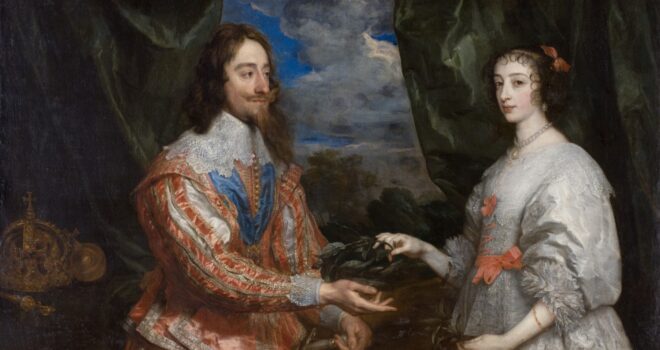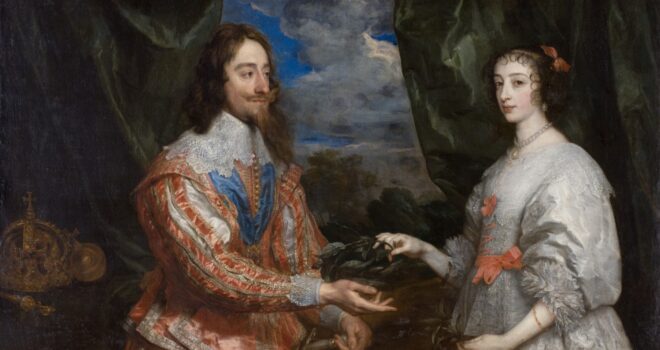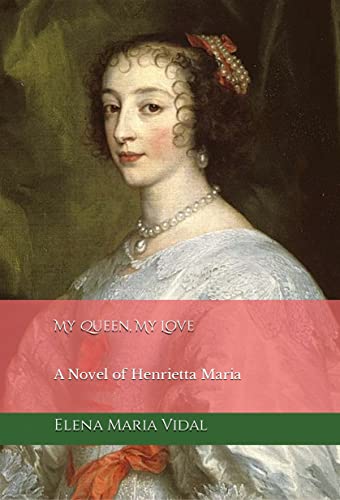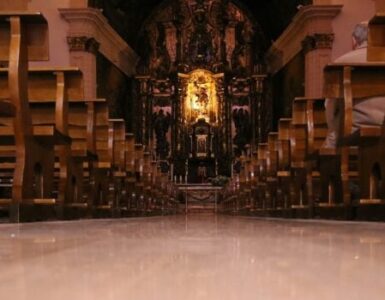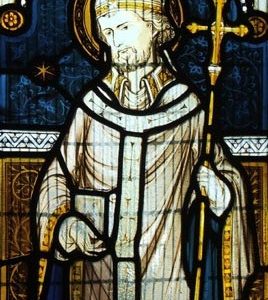Elena Maria Vidal’s historical fiction novel My Queen, My Love: A Novel of Henrietta Maria dramatizes the marriage of French Catholic Henrietta Maria to Protestant Charles I (Stuart) of England.
After the Anglican revolution of Henry XIII, the English royal house was divided. Protestant Elizabeth I died with no issue. Despite Mary Queen of Scots’ heroic witness unto death for the true Faith, her son James was effectively hijacked by her enemies and groomed into a Tudor heir. By the time James’ son Charles ascended the throne, the Stuart dynasty was strongly within the Protestant camp, though his potential conversion remained a hoped-for (or dreaded) eventuality.
The long line of English Catholic martyrs marched forward even during the “tolerant” reign of the Stuarts: most notably, Jesuit priest Fr. Edmund Campion was hanged, drawn, and quartered at Tyburn in 1581.
Anti-Catholic sentiment reigned supreme. The “ringing island” rang no longer, instead clamoring dissonant peals of error.
Into this hostile territory entered a young Catholic princess, Henrietta Maria of France. The daughter of Henry IV, a French Huguenot, and Catholic Marie de’Medici, Henrietta was sent not only as a political envoy, as was the routine purpose of royal marriages, but also as a religious ambassador. Her parents’ marriage, by which the Church partially attempted to heal the French Huguenot schism, provided a model, albeit a rocky one.
The marriage of Henrietta and Charles required a dispensation from the pope, as Catholics were forbidden to marry non-Catholics except in extreme or unusual circumstances. The dispensation came with a weighty caveat: that Henrietta would endeavor to convert her husband, and consequently his country, back to the true Faith. Henrietta was instructed to imitate saint Berthe, who had converted her pagan husband, and sent into the spiritual warzone.
Henrietta arrived in England at the tender age of fifteen, with this outsized supernatural mission to complete.
The challenges commenced immediately. Henrietta was snubbed at court, even sometimes by her husband, who was easily influenced by his anti-Catholic advisor George Villiers, Duke of Buckingham. Her French entourage was replaced by Buckingham’s family, limits were placed upon her public reception of Catholic sacraments, and the terms of the marriage agreement were frequently violated, up to and including an effectual theft of her dowry to wage war against her home country of France.
Vidal does a good job of arousing the reader’s anger on Henrietta’s behalf, especially when Charles continuously prioritizes Buckingham’s wishes and petty politics over his wife’s supernatural faith.
Vidal also highlights the double bind of obedience that characterized Henrietta’s struggles: the competing goals of her sacramental marriage and her devotion to the Faith. As the narrator muses: “Most of her troubles had come because she had tried to be obedient to both her husband and her priests.”
Henrietta combatted this all-encompassing persecution in several ways.
First, she maintained a strict regimen of prayer, fasting, and private devotion. The novel has her reading from St. Francis de Sales’ Introduction to the Devout Life and interpreting the bishop’s words for the unique duties demanded by her state in life. She had private chapels and a coterie of clergy to provide for her spiritual needs, even if her access to them was often obstructed. In a letter to her mother, Henrietta described her life almost as that of a prisoner: she lived in a gilded cage of palaces but was stripped of freedom and agency. Under these circumstances, she embraced an almost monastic lifestyle of prayer and isolation, refusing to fall into sin, yet trying her best not to rock the boat.
Second, Henrietta bravely displayed public acts of Catholic piety and promoted policies to help Catholics, undertaking works of solidarity and charity.
She notably made a pilgrimage to the site of St. Edmund Campion’s martyrdom at Tyburn, for which she was punished by Charles. Infuriatingly, even the French Catholic ambassadors encouraged her to downplay her Catholicism in public after this event, with the hope that greater acquiescence would foster ecumenical peace and harmony.
At certain points, she convinced Charles to free Catholic prisoners on special occasions, and build Catholic chapels for her court. Charles also named the province (now state) of Maryland for his wife, allowing Lord Baltimore to establish the territory as a Catholic enclave. Despite these efforts, Henrietta was ultimately unable to secure a strong political standing for English Catholics.
Finally, Henrietta made difficult and painful decisions about her degree of participation in the English court, keeping always in mind that her husband was also the leader of a false Church. Notably, she refused to attend Charles’ coronation since it included a sacrilegious schismatic ceremony—the Anglican Mass. Catholics are forbidden to attend ceremonies of false religions and schismatic sects, under pain of sin against the first commandment (Catholics who gleefully celebrated the recent coronation of (still Protestant) King Charles III should take note!)
Henrietta’s decisions to opt out of Anglican rituals and court events not only threatened her popularity as queen, but strained her marriage. She therefore dealt with public and private consequences of her displays of faith.
In terms of historical importance, Henrietta’s experience is often reduced to its geopolitical significance as preamble to the English Civil War, where she would distinguish herself as the “majesty-generalissima.” Vidal’s book stops short of the Civil War and subsequent Restoration, allowing her to more deeply examine Henrietta’s conduct during the early tumultuous years of her mixed marriage. Because of this magnified scope, Vidal’s book provides an important look at the consequences this marriage had for the souls of all involved, and the life of the Church in hiding.
Despite propaganda during the Civil War that Henrietta had turned Charles into a Catholic, he never actually converted. And, as we know in retrospect, neither did England. Yet Henrietta did manage to heroically live out her initial mission to the best of her ability. While she did not succeed in converting Charles, she did convert many of her courtiers, including the “court dwarf” Jeffrey Hudson. The souls of these members of her household no doubt owe their salvation in part to her influence. She also provided unmatched example and spiritual (and sometimes political) support to the beleaguered Catholics of England.
Yet there were greater challenges for souls looming ahead: due to Charles’ influence, Henrietta was not able to complete her duty to bring up all her children in the Catholic faith.
Charles mandated that each of the couple’s seven children be baptized Anglican. Two died in childbirth. Two remained Protestant. Yet Henrietta’s prayers and sacrifices became increasingly evident, as there were three notable Catholic conversions among her children.
The couple’s son and heir Charles II remained Protestant throughout his reign, despite frequently expressing desires to convert. It was unclear whether these desires were political or sincere, especially given the king’s debauched lifestyle. He vacillated until the very day of his death, when he was received into the Roman Catholic Church.
Upon Charles’ death in 1685, his younger brother James VII, by now a staunch Catholic, ascended the throne. Against his brother’s wishes, James had converted in the 1660s—the exact time of conversion is debated, because he continued to save face by attending Anglican services for a time after his heart was converted. He would become the last Catholic monarch of England.
Henrietta was able to raise one child in the Church from her childhood. Upon Charles I’s execution in 1649, Henrietta resolved to raise their youngest daughter Henrietta Anne, then four years old, as a Roman Catholic. The younger Henrietta would marry back into the French royal family, and remained Catholic until her death.
The royal patchwork of back and forth conversions, often determined by marriage or politics, raises important questions about the wisdom of these choices.
Regardless of the political significance of these marriages, they highlight the great risk of “flirt to convert” played out at the highest level. Sometimes heroic, this tendency could often be cavalier with souls—sending naïve young Catholics from the bosom of their faith into hostile territory where apostasy was all but inevitable.
Henrietta Maria kept this precarious balance as carefully as she could, violating neither the sacred promises of her marriage nor the fundamental promises of her religion. Her example is becoming all the more relatable as the battle lines of the Church continue to be redrawn, and the laity wonder at their duty to publicly live the Faith in an era of swift cancellation.
Because she was queen, Henrietta’s Catholicism was examined under the microscope of public attention. But it is interesting to note that there were many “secret Catholics” in her court, whose identities are revealed throughout the book.
Katherine Manners, wife of the scheming, virulently anti-Catholic Duke of Buckingham, was herself a secret Catholic. Katherine initially apostatized to the Church of England in order to marry the Duke, but within a few years had returned to the Roman Catholic Church and the practice of the Catholic faith. This revelation comes as a surprise to Henrietta in the book, but she soon finds an unlikely ally in Katherine. It made me wonder how ubiquitous this phenomenon was—women who simply gave up trying to practice their faith publicly, but who still maintained inner conviction. Throughout the novel, Henrietta is constantly discovering new “secret Catholics” among the ranks of her husband’s court, including secret priests. Many of these secret Catholics, including her future son James II, led double lives, often attending Anglican services to keep up appearances, and then assisting at Mass on their own time. The nobility had an advantage in that they had access to private chapels and personal clergy, luxuries not available to the average persecuted Catholic.
The term “secret Catholic” seems a bit of an oxymoron. Catholics are bound to preach the Faith openly, not to hide. To “Go, therefore, and teach ye all nations.”
Yet even Henrietta’s Catholic advisors told her to downplay her faith, in a sense. They said it was best in the long run: it was a matter of tact, not weakness. There is a vast gray area between tact and cowardice, and martyrdom is not in God’s plan for everyone. No one can deny that Henrietta Maria’s experiences constituted years of white martyrdom. Only God ultimately can judge the souls of Catholics placed in these impossible circumstances, and their various iterations throughout the ages. Henrietta walked an incredibly fine line in order to fulfill her duties to God, her husband, and her country. Her example proves edifying and relevant to Catholic living in non-Catholic lands.
Vidal adeptly decodes the complex genealogy of the royals, weaving it back together in narrative form. She dedicates much of the book to intimate introspections on Charles and Henrietta’s fraught but loving marriage, and creates a detestable villain in Buckingham. She does take some artistic liberties with the historical record, all the while operating in the realm of possibilities (wait until you see who she has responsible for the assassination of Buckingham!). Overall, the book is a compelling, readable introduction to a topic I knew little about, by drawing out themes that I study in other contexts: namely secret Catholics, white martyrdom, and the distinction between political and religious persecution.
My Queen, My Love: A Novel of Henrietta Maria is available for purchase on Amazon.
Image: Portrait of Charles I and Queen Henrietta Maria, by Anthony van Dyck, 1632, Kroměříž Castle, via Wikimedia Commons.


